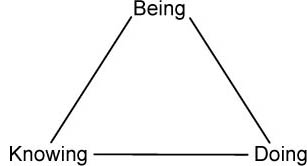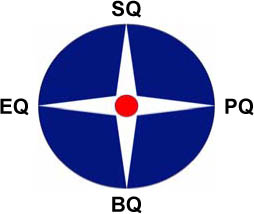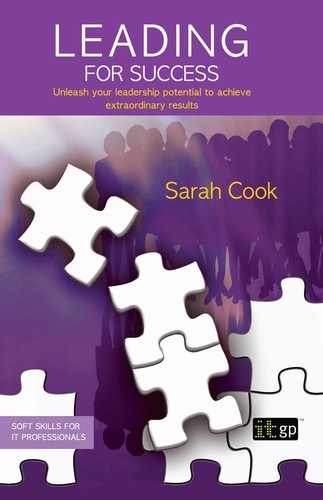CHAPTER 3: LEADING YOURSELF
In this chapter I outline:
• Why it is important that you increase your self awareness to become a better leader
• Techniques you can use to increase your self-awareness
• A self-assessment leadership model.
Increasing your self-awareness as a leader
It is commonly acknowledged that there are three basic ways to become a leader:
• Some people demonstrate extraordinary leadership qualities in a crisis or important event, which causes them to rise to the occasion.
• Some people are born with natural personality traits that lead them into leadership roles.
• Some people can learn leadership skills and choose to become leaders. I am sure that this applies to you and it is the principle on which this book is based.
In order to learn to be a leader, therefore, you need to be conscious of who you are, of how others perceive you and of what your strengths and development areas are.
As we saw in Chapter 1, when followers decide whether or not they are willing to be led by you, they make decisions based on your behaviours, as well as on how you are. The basis of good leadership in your team members’ eyes is how you are (being), what your beliefs are and what your character is like, for example; what you know (knowing), your skills, knowledge and experience, for example; and what you do (doing), such as setting direction, inspiring others and following through.

Figure 12: Being, knowing, doing
So what do you know about yourself? How comfortable are you with what you stand for? What aspects of your leadership do you need to develop?
Using feedback from others
Within your organisation, you probably have methods open to you to help gather feedback from others on what they perceive to be your strengths and your areas for development. This could be feedback you have received from customers and colleagues, from your manager and from team members. It could be part of performance reviews, one-to-one discussions or a more formal 360° feedback process. You can also ask friends and family for their feedback.
Self-assessment using the leadership compass
One way of assessing who you are, what are your strengths and development areas are as a leader, is to use the leadership compass as an assessment tool.
Recent research has illustrated that the most important qualities of the effective leader are not the disconnected set of skills or knowledge that they possess. Rather, they relate to four intelligences: business intelligence (BQ), political intelligence (PQ), spiritual intelligence (SQ) and emotional intelligence (EQ). In essence, these represent the following:
• Business intelligence: the foresight to envision the future and the drive to move the business forward.
• Spiritual intelligence: knowing who you are, self-belief and sense of purpose. Creativity is a subset of this intelligence.
• Political intelligence: knowing the bases of power, knowing who to influence and how.
• Emotional intelligence: recognising others’ feelings, building strong trusting relationships.
Depicted as four points of a compass, these intelligences help leaders to navigate well in their roles.

Figure 13: The leadership compass
Like the four points of a compass, they have equal weight. If the leader is missing one or more of the intelligences, the compass becomes unbalanced and unreliable, the pathway becomes unclear.
Business intelligence involves:
• Business expertise or competence.
• Thinking ahead strategically.
• Listening to and anticipating customer demands.
• Planning to meet customer demands.
• Developing customer-driven offerings and solutions.
• Taking opportunities to improve services to the customer.
Leaders with business intelligence anticipate changing customer demands. They translate this knowledge into service offers and operational processes that deliver successfully to the customer. They are proactive in managing customer expectations and ensure that their businesses are customer-friendly.
Emotional intelligence is the ability to recognise one’s own and others’ emotions; the impact that these emotions have is critical. Behaviours which demonstrate emotional intelligence include:
• Being self-aware and understanding your own feelings.
• Recognising and understanding the feelings of others.
• Listening.
• Being open and empathic.
• Sharing feelings.
• Appreciating others.
Emotions and feelings play a much bigger role in change than is sometimes recognised in a rationally oriented management world.
Spiritual intelligence is sometimes described as having an understanding of one’s values and contribution in life, as knowing:
• Your life purpose.
• Your personal goals and contribution.
• The value you bring to ‘the world’.
Political intelligence, as I define it, involves:
• Being aware of power bases.
• Understanding sources of power.
• Recognising levers of influence during change.
• Developing strategies for influence.
• Gaining buy-in from stakeholders.
PQ, BQ, SQ and EQ add up to the qualities that leaders need in order to drive high performance at work:
• Business intelligence provides the vision and strategy for the future, the sound business case for moving forward, the credible drive and inspiration to others.
• Spiritual intelligence provides the sense of purpose and the self-belief that leaders need.
• Emotional intelligence engenders positive relationships; it provides nurturing qualities and creates positive team spirit.
• Political intelligence promotes understanding of stakeholders’ issues and concerns, of networking and of why buy-in is necessary to change.
Identify your strengths
It is probable that we have refined one or two of the intelligences rather more than others and that you feel comfortable using these preferred or favoured ones. However, effective leaders need to have high levels of intelligence in all four areas. Use the following assessment to identify your leadership strengths and areas for development.
Look at the descriptors in the four sections below. Put a tick beside the ones that best describe you. The results will help you to start to assess your leanings on the leadership compass, and your strengths. In this context there are no rights and wrongs, and it works best if you give your first reactions rather than ponder for a long time over each word.
Table 2: Leadership compass assessment
Now look at the box or boxes with the highest number of ticks and the second-highest number of ticks.
Section 1 relates to action-oriented behaviour – if you scored the highest or second highest in this area your BQ and PQ are likely to be more developed than your EQ and SQ. The rationale is that your imperative for action may override concerns for individuals or perhaps block out wider, longer-term reflection and inner sense of purpose.
Section 2 relates to order-oriented behaviour – if you scored the highest or second highest in this area your PQ and BQ may be more developed than your EQ and SQ. A high score here suggests a potential rigidity in times of change, which will not easily allow new data into your mindset.
Section 3 relates to nurture-oriented behaviour – if you scored the highest or second highest in this area your EQ and SQ may be more developed than your BQ and PQ. A relatively high score implies a concern for people which can sometimes dominate the need to take objective business decisions or to take decisions to win over power bases and critical enemies.
Section 4 relates to creative-oriented behaviour – if you scored the highest or second highest in this area your SQ and EQ may be more developed than your BQ and PQ. A highly creative approach is not always suited to the realities of business and you may feel impatient with those who block fresh ideas. You may certainly be driven by your own sense of mission.
If you have the same score in two or three areas, look at the area or areas where you have the lowest scores. This is where you need to develop.
Below is a summary of the potential outcomes of your self assessment.
Figure 14: Order, action, nurture, creativity
Activity to undertake with your team
As a means of checking if your own perception of yourself is correct, ask someone in your team who knows you well to undertake the same assessment, then compare scores.
Identifying leadership potential
We have the potential to use all points of the leadership compass, but the chances are that you are well practised in using the areas at work where you scored highest. The challenge is to raise your comfort levels with the points of the compass where you scored lowest. You can do this by learning skills, attitudes and approaches that I outline in this book. You can also read Cook, Macaulay and Coldicott’s Effective Change Management for more details on BQ, SQ, EQ and PQ.
Summary
The starting point for developing your leadership skills is to create awareness of your strengths and development areas in terms of leadership. You can do this by asking others formally or informally for feedback. You can also use the leadership compass as the starting point for increasing your self-awareness.
Here are some questions to ask of yourself and others:
• What are my skills and qualities as a business leader? How good am I at setting direction, goals and strategy for the future?
• How able am I to read the political situation and influence others effectively?
• What are my relationships with others like? How empathic am I to others’ needs?
• What are my personal values? How do they act as guiding principles for me as a leader?

